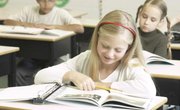Drawing conclusions is a way of inferring information from a text. Instead of remembering what is directly stated, readers interpret clues in what's written. Third-graders are usually skilled enough readers and thinkers to start making inferences while reading independently. Drawing conclusions can help third-graders figure out the meanings of new words, predict what will happen next in a story and understand characters' and authors' motivations.
Picture It
"Picture It" is an activity that teaches students what it means to draw conclusions, or to infer. In this activity, students will draw conclusions from pictures in a book. David Shannon's "No, David!" is a great book with which to start, as the pictures tell most of the story. You should have students draw conclusions about the story by looking at the pictures as you read.
A follow-up activity is to show them a book such as "Smoky Night" by Eve Bunting. First, have them tell you the story just from looking at the pictures, then read it together. The most important thing is to make sure the students explain why they are drawing the conclusions they are; for example, "There were tears on her face, so I knew she was sad."
Guess That Word
Teaching an abstract concept, such as drawing conclusions, means that teachers should make sure students understand the thinking process behind the skill. Move from drawing conclusions from pictures to drawing conclusions from simple sentences. You can work on this by changing a word in familiar text, then encouraging students to figure out what the word means.
For example, students might read, "He procured a new coat for her after she lost her old one." Then you can discuss what they think "procured" means and explain that they are drawing a conclusion because the text doesn't directly state what the word's meaning is.
Name That Emotion
Readers often need to make inferences about characters while reading. In this activity, you'll write a descriptive paragraph about a character experiencing a certain emotion without actually naming the emotion. Then students will guess the correct emotion.
Next, you can pair up students and have each pair write a descriptive paragraph. Then pairs should trade paragraphs and guess what the other's emotion is. This will allow students to practice drawing conclusions from longer pieces of text as well as help them practice writing descriptive paragraphs that imply information.
Related Articles
Writer Bio
Jennifer Zimmerman is a former preschool and elementary teacher who has been writing professionally since 2007. She has written numerous articles for The Bump, Band Back Together, Prefab and other websites, and has edited scripts and reports for DWJ Television and Inversion Productions. She is a graduate of Boston University and Lewis and Clark College.











